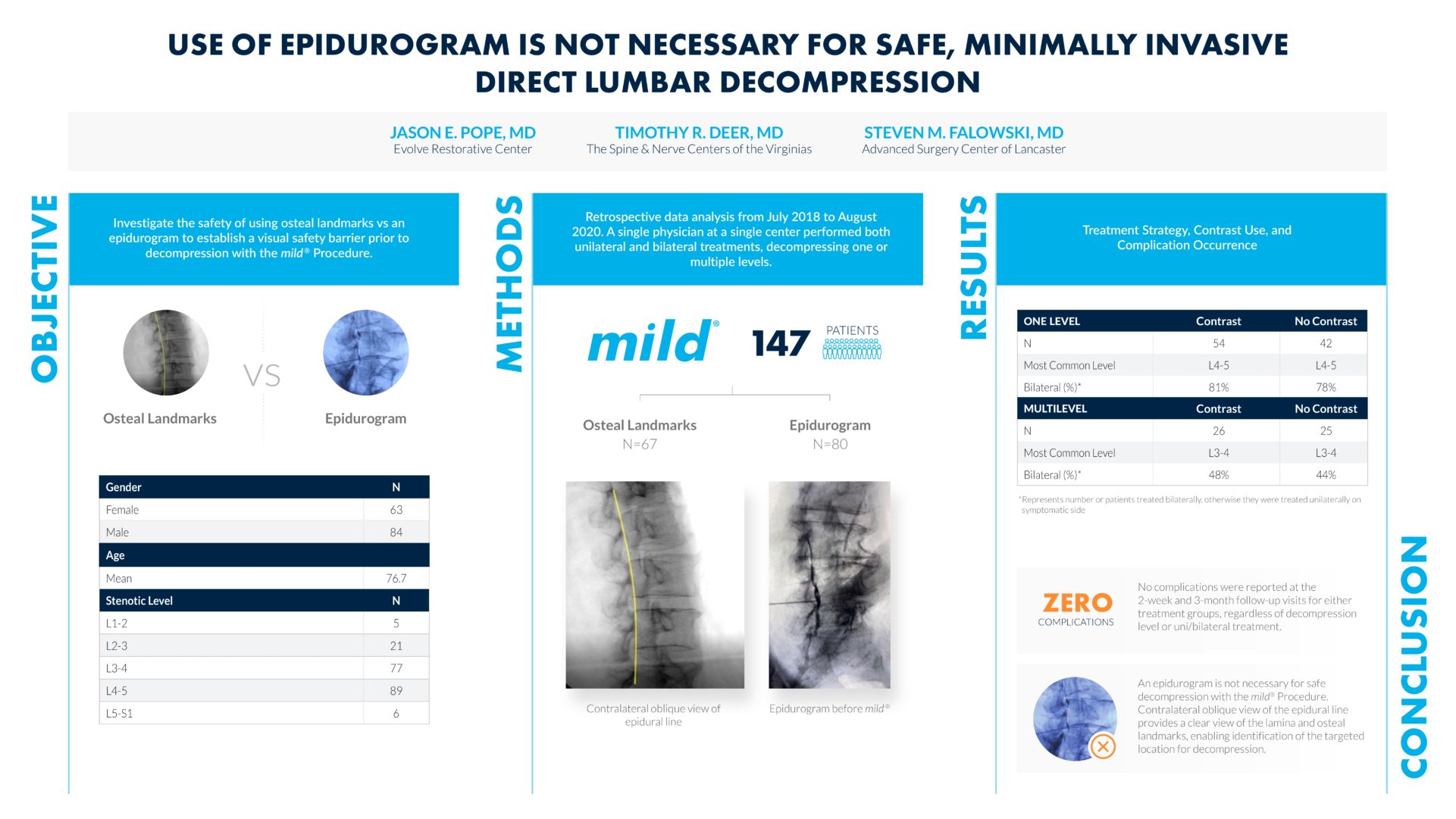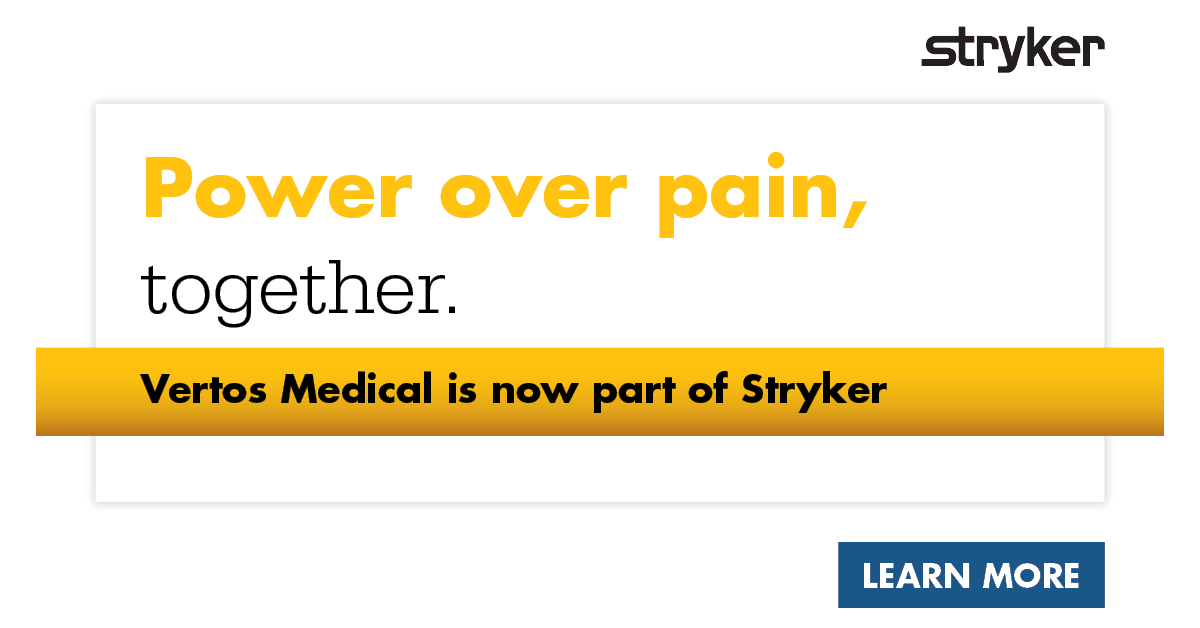ASPN Abstract: Use of Epidurogram is Not Necessary for Safe, Minimally Invasive Direct Lumbar Decompression
Author— Jason E. Pope, MD Published July 22, 2021
The objective of the study “Use of Epidurogram is Not Necessary for Safe, Minimally Invasive Direct Lumbar Decompression” was to investigate the safety of using osteal landmarks vs an epidurogram to establish a visual safety barrier prior to decompression with the mild® Procedure. A retrospective data analysis was performed on 147 patients that compared those receiving an epidurogram with performance of the mild® Procedure versus those that did not. View the abstract poster below to learn more about the outcomes.

Watch Dr. Jason Pope present his abstract from the American Society of Pain and Neuroscience’s (ASPN) Third Annual Conference where he shares why the use of an epidurogram is not necessary for safe decompression with the mild® Procedure.
Eager to further understand the mild® Procedure and how it can put your lumbar spinal stenosis patients on the path to long-term relief? Contact Vertos Medical and discover why leading interventionalists offer mild® in their practice.
This study was recently published in the Journal of Pain Research, click here to view.
Jason Pope, MD (00:00)
Well, welcome everyone. My name is Dr. Jason Pope. I have a practice in Northern California serving Napa, Sonoma, Mendocino counties and I’m here today to talk a little bit about an innovative strategy that we had in performing the mild® Procedure. And the question that we were trying to answer with this was essentially, “Is the epidurogram necessary when executing the mild® Procedure on patients, whether you’re going to perform a single level or a multilevel strategy?” And so we retrospectively looked at 147 patients. So we can see here the female to male breakdown along with a median age of around 77. And we looked at patients that either got the epidurogram with performance of the mild® [Procedure] versus those that did not. And we did so equitably across the patient population that we were serving. And as we can see with a stenotic level, clearly the most common areas that were performed were at L3-4 and L4-5 and that’s no surprise. And then we looked at patients whether they were done as a single level or a multilevel. And we can see here that the breakdown of these patients where 54 patients received contrast, 42 non-contrast, in a single level. And the most common level that was performed was at L4-5. But what was also very interesting was in this retrospective review, again, of about 147 patients, about 80% of them had the procedure done bilaterally if it was at a single level. And interestingly enough, when we did a multilevel mild®, and in this cohort, it represented at least two levels, the most common level that was the index level of where it was treated was at L3-4 and bilaterally, this was performed nearly 50% of the time. So when people do multiple levels of [the] mild® Procedure, the unilateral reality based on symptoms changes a little bit as compared to if you were doing a single level.
(02:27) And again, this was done over a total cohort of 147 patients. And the way that this came about and again, we highlighted the fact that when we looked at the use of epidurogram in managing patients with spinal stenosis symptomatically, with the mild® Procedure, it wasn’t clear that it really offered an increase in safety. And it wasn’t clear that it highlighted when the decompression was completed because epidural flow after decompression doesn’t necessarily increase after the ligament is trimmed or resected. So we looked at trying to simplify the procedure, and this was done just by using the osteal landmarks. And we can see the facet line and the laminar line in the middle section of the abstract presentation here. And I can say with confidence, using osteal landmarks alone as compared to the epidurogram, and we use the midline incision, the refined Streamlined Technique that you all have come to know and love, that in performing this, there were zero complications, as defined as problems with infection, nerve injury, allergy to contrast, which is something that can happen, but clearly in this cohort, it did not.
And so there were zero complications performing either one level or multilevel [mild®], either unilaterally or bilaterally with contrast or without contrast. So this underscores the importance and the strategy that if one chooses or elects to not use the epidurogram in performance of the mild® [Procedure] you can do so safely, based on this patient cohort. So again, appreciate your time. I want to also thank my co-authors associated with this project, Dr. Timothy Deer and Dr. Steven Falowski. And I want to also thank the Vertos team for helping with the assembly of the abstract. So with that, thank you.
Benyamin RM, Staats PS, MiDAS ENCORE Investigators. mild® is an effective treatment for lumbar spinal stenosis with neurogenic claudication: MiDAS ENCORE Randomized Controlled Trial. Pain Physician. 2016;19(4):229-242.
Mekhail N, Costandi S, Abraham B, Samuel SW. Functional and patient-reported outcomes in symptomatic lumbar spinal stenosis following percutaneous decompression. Pain Pract. 2012;12(6):417-425. doi:10.1111/j.1533-2500.2012.00565.x.
2012 data from Health Market Sciences report for Vertos Medical 2013.
Data on file with Vertos Medical.
Staats PS, Chafin TB, Golvac S, et al. Long-term safety and efficacy of minimally invasive lumbar decompression procedure for the treatment of lumbar spinal stenosis with neurogenic claudication: 2-year results of MiDAS ENCORE. Reg Anesth Pain Med. 2018;43:789-794. doi:10.1097/AAP.0000000000000868.
Based on mild® Procedure data collected in all clinical studies. Major complications are defined as dural tear and blood loss requiring transfusion.
MiDAS ENCORE responder data. On file with Vertos Medical.
Jain S, Deer TR, Sayed D, et al. Minimally invasive lumbar decompression: a review of indications, techniques, efficacy and safety. Pain Manag. 2020;10(5). https://doi.org/10.2217/pmt-2020-0037. Accessed June 1, 2020.
Deer TR, Grider JS, Pope JE, et al. The MIST Guidelines: the Lumbar Spinal Stenosis Consensus Group guidelines for minimally invasive spine treatment. Pain Pract. 2019;19(3)250-274. doi:10.1111/papr.12744.
Hansson T, Suzuki N, Hebelka H, Gaulitz A. The narrowing of the lumbar spinal canal during loaded MRI: the effects of the disc and ligamentum flavum. Eur Spine J. 2009;18(5):679-686. doi:10.1007/s00586-009-0919-7.
Treatment options shown are commonly offered once conservative therapies (e.g., physical therapy, pain medications, chiropractic) are not providing adequate relief. This is not intended to be a complete list of all treatments available. Doctors typically recommend treatments based on their safety profile, typically prioritizing low risk/less aggressive procedures before higher risk/more aggressive procedures, but will determine which treatments are appropriate for their patients.
The mild® Procedure is a minimally invasive treatment for lumbar spinal stenosis. As with most surgical procedures, serious adverse events, some of which can be fatal, can occur, including heart attack, cardiac arrest (heart stops beating), stroke, and embolism (blood or fat that migrates to the lungs or heart). Other risks include infection and bleeding, spinal cord and nerve injury that can, in rare instances, cause paralysis. This procedure is not for everyone. Physicians should discuss potential risks with patients. For complete information regarding indications for use, warnings, precautions, and methods of use, please reference the devices’ Instructions for Use.
Patient stories on this website reflect the results experienced by individuals who have undergone the mild® Procedure. Patients are not compensated for their testimonial. The mild® Procedure is intended to treat lumbar spinal stenosis (LSS) caused by ligamentum flavum hypertrophy. Although patients may experience relief from the procedure, individual results may vary. Individuals may have symptoms persist or evolve or other conditions that require ongoing medication or additional treatments. Please consult with your doctor to determine if this procedure is right for you.
Reimbursement, especially coding, is dynamic and changes every year. Laws and regulations involving reimbursement are also complex and change frequently. Providers are responsible for determining medical necessity and reporting the codes that accurately describe the work that is done and the products and procedures that are furnished to patients. For this reason, Vertos Medical strongly recommends that you consult with your payers, your specialty society, or the AMA CPT regarding coding, coverage and payment.
Vertos Medical cannot guarantee coding, coverage, or payment for products or procedures. View our Billing Guide.
Vertos is an equal employment opportunity workplace committed to pursuing and hiring a diverse workforce. We strive to grow our team with highly skilled people who share our culture and values. All qualified applicants will receive consideration for employment without regard to sex, age, color, race, religion, marital status, national origin, ancestry, sexual orientation, gender identity, physical & mental disability, medical condition, genetic information, veteran status, or any other basis protected by federal, state or local law.
Hall S, Bartleson JD, Onofrio BM, Baker HL Jr, Okazaki H, O’Duffy JD. Lumbar spinal stenosis. Clinical features, diagnostic procedures, and results of surgical treatment in 68 patients. Ann Intern Med. 1985;103(2):271-275. doi:10.7326/0003-4819-103-2-271.
Kalichman L, Cole R, Kim DH, et al. Spinal stenosis prevalence & association with symptoms: The Framingham Study. Spine J. 2009;9(7):545-550. doi:10.1016/j.spinee.2009.03.005.
Fukusaki M, Kobayashi I, Hara T, Sumikawa K. Symptoms of spinal stenosis do not improve after epidural steroid injection. Clin J Pain. 1998;14(2):148-151. doi:10.1097/00002508-199806000-00010.
Mekhail N, Costandi S, Nageeb G, Ekladios C, Saied O. The durability of minimally invasive lumbar decompression procedure in patients with symptomatic lumbar spinal stenosis: Long-term follow-up [published online ahead of print, 2021 May 4]. Pain Pract. 2021;10.1111/papr.13020. doi:10.1111/papr.13020
Friedly JL, Comstock BA, Turner JA, et al. Long-Term Effects of Repeated Injections of Local Anesthetic With or Without Corticosteroid for Lumbar Spinal Stenosis: A Randomized Trial. Arch Phys Med Rehabil. 2017;98(8):1499-1507.e2. doi:10.1016/j.apmr.2017.02.029
Pope J, Deer TR, Falowski SM. A retrospective, single-center, quantitative analysis of adverse events in patients undergoing spinal stenosis with neurogenic claudication using a novel percutaneous direct lumbar decompression strategy. J Pain Res. 2021;14:1909-1913. doi: 10.2147/JPR.S304997
Pryzbylkowski P, Bux A, Chandwani K, et al. Minimally invasive direct decompression for lumbar spinal stenosis: impact of multiple prior epidural steroid injections [published online ahead of print, 2021 Aug 4]. Pain Manag. 2021;10.2217/pmt-2021-0056. doi:10.2217/pmt-2021-0056
Abstract presented at: American Society of Pain and Neuroscience Annual Conference; July 22-25, 2021; Miami Beach, FL.
Mobility Matters: Low Back Pain in America, Harris Poll Survey, 2022. View data and full summary here.
Deer TR, Grider JS, Pope JE, et al. Best Practices for Minimally Invasive Lumbar Spinal Stenosis Treatment 2.0 (MIST): Consensus Guidance from the American Society of Pain and Neuroscience (ASPN). J Pain Res. 2022;15:1325-1354. Published 2022 May 5. doi:10.2147/JPR.S355285.

